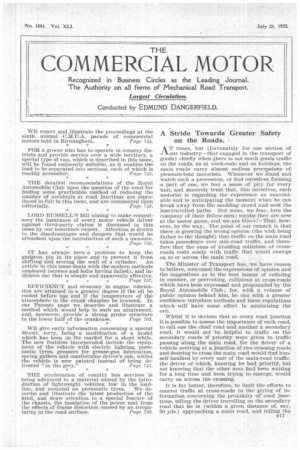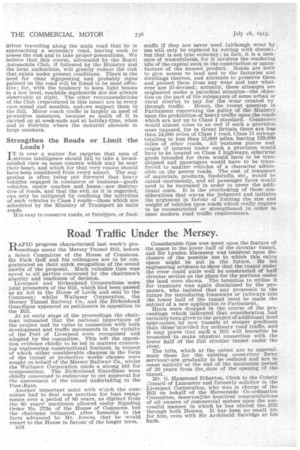A Stride Towards Greater Safety on the Roads.
Page 1

Page 2

If you've noticed an error in this article please click here to report it so we can fix it.
AT times, but (fortunately for one section of our industry—that engaged in the transport of goods) chiefly when.there is not much goods traffic on the roads, as at week-ends and on holidays, the main roads carry almost endless processions of pleasure-bent motorists. Whenever we tand and watch such a procession, or find ourselves forming a part of one, we feel a sense of pity for every unit, and sincerely trust that, like ourselves, each motorist is regarding the experience as unavoidable and is anticipating the moment when he can break away from tile madding crowd and seek the less-travelled paths. But some, we fear, love the company of their fellow-men ; maybe they are new at the motor game, and we are blemalThat, however, by the way. The point of our remark is that there is growing the wrong opinion (the wish being father to the thought) that traffic on the main road takes precedence over side-road traffic, and therefore that the onus of avoiding collisions at crossroads reSts solely with traffic that would emerge on to or across the main road.
The Minister of Transport has, we have reason to believe, welcomed the expressions of opinion and the suggestions as to the best means of reducing in number, or preventing, collisions at cross-roads which have.been expressed and propounded by the Royal Automobile Club ; for, with a volume of public opinion behind him, he can with a greater confidence introduce methods and issue regulations which will have some effect in minimizing the evil, ' Whilst if is obvions that at •every road junction it is possible to assess the importance of each road, to call one the chief road and another a secondary road, it would not be helpful to traffic on the secondary roads if priority, were given to traffic passing along the main road, for the driver of a vehicle arriving at a junction of two crossing roads and desiring to cross the main road would find himself baulked by every unit of the main-road traffic, the driver of. which, knowing he had priority, but not knowing that the other man had been waiting for a long time and been trying to emerge, would carry on across the crossing.
It is far better, therefore, to limit the efforts to control traffic at cross-roads to the giving of in'formation concerning the proximity of road junctions, telling the driver travelling on the secondary road that he -Is (within a given distance of, say, 50 yds.) approaching a main road, and telling the driver travelling along the main road that he is approaching a secondary road, leaving each to assess the risk and to take proper precautions, We believe that this course, advocated by the Royal Automobile Club, if followed by the Ministry and the local authorities, will greatly reduce the risk that exists under present conditions. There is the need for clear signposting and probably signs painted on the road will be found to be most effective; for, with the tendency to keep light beams to a low level, roadside signboards are not always observable at night. The other recommendations of the Club (reproduced in this issue) are in every case sound and sensible, andtwe support them to the full. Motor coach traffic is largely in need of protective measures, because so much of it is carried on at week-ends and at holiday-time, when and in districts where the motorist abounds in large numbers.
Strengthen the Roads or. Limit the Loads ?
Tr is ever a matter for surprise that men of lobvious intelligence should fail to take a broadminded view on some concern which may be near their heart, and which for that very reason should have been considered from every aspect. The suggestion is often being put forward that heavy vehicles engaged in commerce or business—goods vehicles, motor coaches and buses—are destructive of roads, and that the evil, as it is regarded, can only be mitigated by confining the activities of such vehicles to Class I roads—those which are scheduled by the Ministry of Transport as main roads.
It is easy to conserve roads, or furniture, or food stuffs if they are never used (although wear by use will only be replaced by rotting with disuse), but that is not true economy ; in fact, it is a measure of wastefulness, for it involves the rendering idle of the capital sunk in the construction or manufacture of the unused product. Roads are built to give access to land and to the factories and dwellings thereon, and attempts to preserve them and protect them from any wear and tear whatever are ill-devised; actually, these attempts are originated .under a parochial stimulus—the objection on the part of the ratepayers of some urban or rural district to pay for the wear created by through traffic. Hence, the recent question in Parliament concerning the policy of the Ministry upon the prohibition of heavy traffic upon the roads which are not up to Class I standard. Commerce would almost come to an end if such a provision were imposed, for in Great Britain there are les,s than 24,000 miles of Class I road, Class II mileage totalling to less than 15,000 miles, leaving 139,000 miles of other roads: All business places and coigns of interest under such a provision would have to be located on Class I highways, otherwise goods intended for them would have to be transhipped and passengers would have to be transferred to smaller vehicles of a character admissible on the poorer roads. The cost of transport of materials, products, foodstuffs, etc., would be raised enormously, and all passenger fares would need to be increased in order to cover the additional costs. It is the overlooking of these considerations that warps the judgment and initiates the argument in favour of limiting the size and weight of vehicles upon roads which really require to be reconstructed or strengthened in order to meet modern road traffic requirements.




























